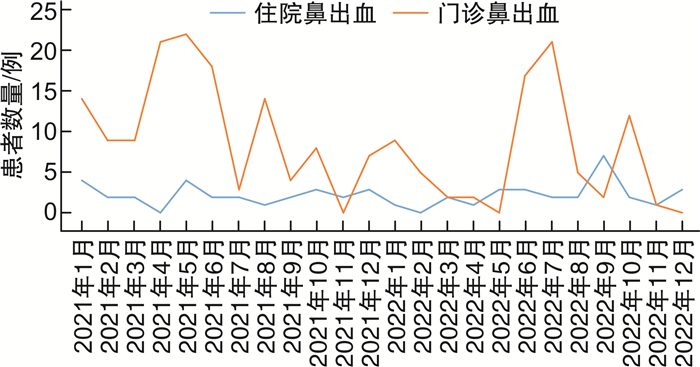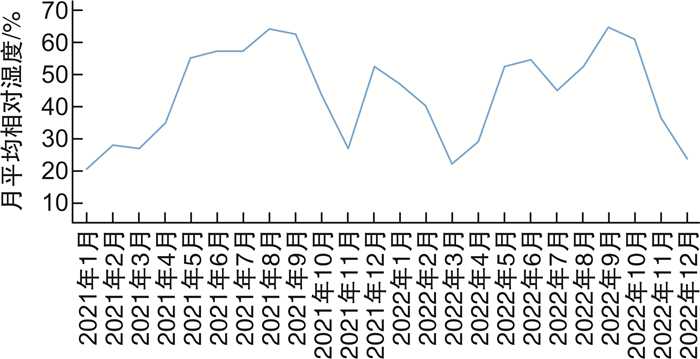Analysis of the relationship between epistaxis and homocysteine and climatic factors in ultra-high altitude area
-
摘要: 目的 分析特高海拔地区鼻出血的相关影响因素,为特高海拔地区鼻出血的防治提供依据。方法 收集2021年1月至2022年12月就诊于那曲市人民医院耳鼻喉科门诊鼻出血患者206例,住院鼻出血患者54例,住院非鼻出血患者69例,比较住院鼻出血患者与非鼻出血患者的既往史、饮酒史、吸烟史以及血清同型半胱氨酸、白细胞数量,红细胞数量,血细胞比容,血红蛋白,平均血红蛋白浓度,对有显著差异的因素进行二元logistic回归分析;收集那曲市2021年1月至2022年12月的月平均气温、气压、湿度、2 min风速,分析门诊、住院鼻出血患者数量与气候要素间的相关性。结果 病例组患者有高血压病史例数多于对照组,差异有统计学意义(P=0.013);病例组血清同型半胱氨酸水平高于对照组(P < 0.001),红细胞数量、血细胞比容、血红蛋白及平均血红蛋白浓度低于对照组,差异有统计学意义(P=0.001、0.001、0.001、0.039);高血压病史、血清同型半胱氨酸含量为鼻出血的危险因素,有高血压病史患者患鼻出血的可能性是无高血压病史患者的3.713倍(P=0.022),血清同型半胱氨酸浓度每增加1,鼻出血患病风险增加13.1%(P=0.001)。结论 那曲地区鼻出血患者血清同型半胱氨酸水平升高,红细胞数量、血细胞比容、血红蛋白浓度及平均血红蛋白浓度降低。高血压病史、同型半胱氨酸为鼻出血的危险因素,有高血压病史患者患鼻出血的可能性是无高血压病史患者的3.713倍,同型半胱氨酸浓度每增加1,鼻出血患病风险增加13.1%,积极干预高血压及血清同型半胱氨酸能有效预防鼻出血的发生。Abstract: Objective To analyze the related influencing factors of epistaxis in extremely high altitude area, and to provide evidence for the prevention and treatment of epistaxis in extremely high altitude area.Methods From January 2021 to December 2022, 206 outpatients with epistaxis, 54 inpatients with epistaxis and 69 inpatients withoutepistaxis in theDepartment of Otorhinolarygology, Naqu People's Hospital were collected. The previous history, drinking history, smoking history, serum homocysteine(Hcy), white blood cell count(WBC), red blood cell count(RBC), hematocrit(HCT), hemoglobin(HGB) and mean hemoglobin concentration(MCHC) were compared between inpatients with or without epistaxis. The factors with significant differences were analyzed by binary Logistic regression. The monthly average temperature, air pressure, humidity and 2-minute wind speed were collected from January 2021 to December 2022 in Naqu City to analyze the correlation between epistaxis and climate factors.Results The number of patients with hypertension in the case group was more than that in the control group, and the difference was significant(P=0.013). Serum Hcy level in the case group was higher than that in the control group(P < 0.001). RBC, HCT, HGB and MCHC were lower than that in the control group(P=0.001, 0.001, 0.001, 0.039), and the difference was significant. History of hypertension and Hcy were risk factors for epistaxis. Patients with a history of hypertension were 3.713 times more likely to suffer from epistaxis than those without a history of hypertension(P=0.022). Each 1 increase in Hcy concentration increased the risk of epistaxis by 13.1%(P=0.001).Conclusion Patients with epistaxis in Naqu area had higher serum Hcy level and lower RBC, HCT, HGB and MCHC. History of hypertension and Hcy were risk factors for epistaxis. Patients with a history of hypertension were 3.713 times more likely to suffer from epistaxis than those without a history of hypertension. Every 1 increase in Hcy concentration increased the risk of epistaxis by 13.1%. Active intervention of hypertension and serum Hcy can effectively prevent the incidence of epistaxis.
-
Key words:
- Naqu of Xizang /
- epistaxis /
- homocysteine /
- climatic factors
-

-
表 1 月门诊、住院鼻出血患者数量与气候要素之间Spearman相关性分析
组别 月平均温度 月平均气压 月平均湿度 月平均2分钟风速 门诊鼻出血患者数量 rs 0.204 0.005 0.213 0.007 P 0.339 0.980 0.319 0.974 住院鼻出血患者数量 rs 0.116 0.104 0.111 0.091 P 0.589 0.629 0.604 0.673 表 2 病例组与对照组既往史、吸烟史、饮酒史比较
例 组别 高血压病 糖尿病 吸烟史 饮酒史 病例组 18 0 1 1 对照组 10 1 2 1 χ2 6.116 - - - P 0.013 1.000 1.000 1.000 表 3 病例组与对照组血清Hcy,WBC,RBC,HCT,HGB,MCHC比较
病例组 对照组 t Z P Hcy/(μmol/L) 26.1(22.4~29.4) 18.2(15.2~21.3) - 5.410 <0.001 WBC/(×109/L) 8.2(6.6~9.9) 7.1(5.6~12.3) - 0.359 0.719 RBC/(×1012/L) 5.2 5.9 3.410 - 0.001 HCT/% 46.3(33.8~53.4) 52.0(46.1~57.9) - 3.196 0.001 HGB/(g/L) 154.5(119.8~175.3) 173.0(155.0~190.5) - 3.407 0.001 MCHC/(g/L) 324.0(306.0~335.0) 328.0(314.0~344.5) - 2.062 0.039 表 4 高血压病史、Hcy、RBC、HCT、HGB、MCHC二元logistic回归分析
回归参数 β S.E Wald Exp(β) 95%CI P 高血压病史 1.312 0.572 5.269 3.713 1.211~11.381 0.022 RBC/(×1012/L) -0.158 0.472 0.112 0.854 0.339~2.153 0.738 HCT/% -0.003 0.026 0.012 0.997 0.948~1.049 0.911 HGB/(g/L) -0.020 0.014 1.919 0.980 0.953~1.008 0.166 MCHC/(g/L) -0.020 0.011 3.463 0.980 0.960~1.001 0.063 Hcy/(μmol/L) 0.123 0.038 10.653 1.131 1.050~1.218 0.001 常量 7.898 4.038 3.826 2 692.385 0.050 -
[1] 史丽, 于鹏, 陈爱平. 鼻出血诊疗策略暨MasterPillar临床应用指导意见[J]. 临床耳鼻咽喉头颈外科杂志, 2023, 37(7): 519-523. https://lceh.whuhzzs.com/article/doi/10.13201/j.issn.2096-7993.2023.07.003
[2] 胡健, 王剑, 许敏, 等. 遗传性出血性毛细血管扩张症8例及相关文献复习[J]. 临床耳鼻咽喉头颈外科杂志, 2021, 35(11): 1031-1034. https://lceh.whuhzzs.com/article/doi/10.13201/j.issn.2096-7993.2021.11.015
[3] Womack JP, Kropa J, Jimenez Stabile M. Epistaxis: outpatient management[J]. Am Fam Physician, 2018, 98(4): 240-245.
[4] Hall AC, Simons M, Pilgrim G, et al. Epistaxis management at Guy's Hospital, 2009-2011: full audit cycles[J]. J Laryngol Otol, 2014, 128(1): 82-85. doi: 10.1017/S0022215113003137
[5] Gilyoma JM, Chalya PL. Etiological profile and treatment outcome of epistaxis at a tertiary care hospital in Northwestern Tanzania: a prospective review of 104 cases[J]. BMC Ear Nose Throat Disord, 2011, 11: 8. doi: 10.1186/1472-6815-11-8
[6] 周焕, 耿杨杨, 汤玮, 等. 鼻出血住院患者的临床特征及易患因素分析[J]. 同济大学学报(医学版), 2023, 44(3): 381-386. https://www.cnki.com.cn/Article/CJFDTOTAL-TJIY202303011.htm
[7] Chaaban MR, Zhang D, Resto V, et al. Demographic, seasonal, and geographic differences in emergency department visits for epistaxis[J]. Otolaryngol Head Neck Surg, 2017, 156(1): 81-86. doi: 10.1177/0194599816667295
[8] Côrte FC, Orfao T, Dias CC, et al. Risk factors for the occurrence of epistaxis: Prospective study[J]. Auris Nasus Larynx, 2018, 45(3): 471-475. doi: 10.1016/j.anl.2017.07.021
[9] Min HJ, Kang H, Choi GJ, et al. Association between hypertension and epistaxis: systematic review and meta-analysis[J]. Otolaryngol Head Neck Surg, 2017, 157(6): 921-927. doi: 10.1177/0194599817721445
[10] Tunkel DE, Anne S, Payne SC, et al. Clinical practice guideline: nosebleed(epistaxis)[J]. Otolaryngol Head Neck Surg, 2020, 162: S1-S38. doi: 10.1177/0194599819889343
[11] Acar B, Yavuz B, Yıldız E, et al. A possible cause of epistaxis: increased masked hypertension prevalence in patients with epistaxis[J]. Braz J Otorhinolaryngol, 2017, 83(1): 45-49 doi: 10.1016/j.bjorl.2016.01.007
[12] Sethi RKV, Kozin ED, Abt NB, et al. Treatment disparities in the management of epistaxis in United States emergency departments[J]. Laryngoscope, 2018, 128(2): 356-362. doi: 10.1002/lary.26683
[13] Mangussi-Gomes J, Enout MJ, Castro TC, et al. Is the occurrence of spontaneous epistaxis related to climatic variables?A retrospective clinical, epidemiological and meteorological study[J]. Acta Otolaryngol, 2016, 136(11): 1184-1189. doi: 10.1080/00016489.2016.1191673
[14] Su DT, Du HD, Zhang XW, et al. Season and outdoor temperature in relation to detection and control of hypertension in a large rural Chinese population[J]. Int J Epidemiol, 2014, 43(6): 1835-1845. doi: 10.1093/ije/dyu158
[15] Seikaly H. Epistaxis[J]. N Engl J Med, 2021, 384(10): 944-951. doi: 10.1056/NEJMcp2019344
[16] Meltzer EO, Farrar JR, Sennett C. Findings from an online survey assessing the burden and management of seasonal allergic rhinoconjunctivitis in US patients[J]. J Allergy Clin Immunol Pract, 2017, 5(3): 779-789. doi: 10.1016/j.jaip.2016.10.010
[17] 索朗杰布, 白宗禧, 王克勤. 高原鼻出血诊治体会[J]. 西藏医药杂志, 2013, 34(1): 12-14. https://www.cnki.com.cn/Article/CJFDTOTAL-XZYY201301007.htm
[18] Tang N, Ma J, Tao RQ, et al. The effects of the interaction between BMI and dyslipidemia on hypertension in adults[J]. Sci Rep, 2022, 12(1): 927. doi: 10.1038/s41598-022-04968-8
[19] 仇燕, 仲怀琴, 缴克华. 不同海拔地区健康体检人群血压的比较分析[J]. 中国疗养医学, 2022, 31(6): 561-564. https://www.cnki.com.cn/Article/CJFDTOTAL-ZGLX202206001.htm
[20] 曹碧红, 吴显劲, 王春晖. 高原地区人群贫血患病情况调查[J]. 医学检验与临床, 2020, 31(12): 24-27. doi: 10.3969/j.issn.1673-5013.2020.12.007
[21] 边巴琼达, 王旭萍. 高原地区藏族居民脉氧饱和度和血红蛋白含量分析[J]. 高原医学杂志, 2018, 28(3): 53-53. https://www.cnki.com.cn/Article/CJFDTOTAL-GYYZ202003002.htm
[22] 国际高原医学会慢性高原病专家小组. 第六届国际高原医学和低氧生理学术大会颁布慢性高原病青海诊断标准[J]. 青海医学院学报, 2005, 26(1): 3-5. doi: 10.3969/j.issn.1006-8252.2005.01.002
[23] 左林, 赵佳, 姜小建, 等. 缺血性脑血管病患者血清同型半胱氨酸、叶酸和维生素B12水平与头颈部血管狭窄的相关性研究[J]. 现代检验医学杂志, 2017, 32(2): 23-25, 29. doi: 10.3969/j.issn.1671-7414.2017.02.006
[24] 陈娜. 叶酸与VitB6联合治疗对高血压合并高同型半胱氨酸血症患者颈动脉硬化的影响[J]. 心血管病防治知识(学术版), 2018, 8(2): 5-7. https://www.cnki.com.cn/Article/CJFDTOTAL-XUGB201804003.htm
[25] 郭立新, 潘琦, 初明峰, 等. 高同型半胱氨酸血症与糖尿病患者颈动脉内膜中层厚度关系及强化控制的影响[J]. 中华内分泌代谢杂志, 2006, 22(1): 19-22. doi: 10.3760/j.issn:1000-6699.2006.01.006
[26] Yu G, Fu Y, Dong C, et al. Is the occurrence of pediatric epistaxis related to climatic variables?[J]. Int J Pediatr Otorhinolaryngol, 2018, 113: 182-187. doi: 10.1016/j.ijporl.2018.07.053
[27] Akdo an MV, Hızal E, Semiz M, et al. The role of meteorologic factors and air pollution on the frequency of pediatric epistaxis[J]. Ear Nose Throat J, 2018, 97(9): E1-E5. doi: 10.1177/014556131809700901
[28] Sowerby LJ, DeSerres JJ, Rudmik L, et al. Role of season, temperature and humidity on the incidence of epistaxis in Alberta, Canada[J]. Le J D'oto Rhino Laryngol De Chir Cervico Faciale, 2014, 43(1): 10.
-





 下载:
下载:



